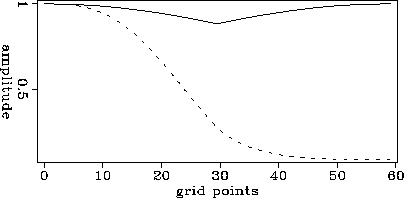




Next: The free boundary and
Up: IMPLEMENTATION
Previous: IMPLEMENTATION
The absorbing boundary conditions in the sides and bottom of
the model are based in the method described by Cerjan et al. (1985), which
is at the same time simple and suitable for implementation in a
parallel architecture. An N-grid-points-thick absorbing region
covers the three absorbing regions. Following each time step, the wavefield
inside this region is multiplied by a Gaussian damping function
![$G = \exp -[(N-i)/\sigma_N]^2.$](img14.gif) , where i is the distance (in grid-points
units) from the boundary. The total attenuation applied to a wavefield
propagating with an extreme velocity of one grid-point per time-step is
, where i is the distance (in grid-points
units) from the boundary. The total attenuation applied to a wavefield
propagating with an extreme velocity of one grid-point per time-step is
|  |
(9) |
as illustrated in Figure ![[*]](http://sepwww.stanford.edu/latex2html/cross_ref_motif.gif) . Stable modeling requires
velocities smaller than that, resulting in a cumulative attenuation
always stronger than that described by equation (9).
One of the nice things about the parallel architecture is the facility
provided by the natural circular boundary conditions. No special
treatment is required for the two sides of the model because the
waves transmitted from one boundary to the other are sufficiently
attenuated to have any significant effect.
absorbing
. Stable modeling requires
velocities smaller than that, resulting in a cumulative attenuation
always stronger than that described by equation (9).
One of the nice things about the parallel architecture is the facility
provided by the natural circular boundary conditions. No special
treatment is required for the two sides of the model because the
waves transmitted from one boundary to the other are sufficiently
attenuated to have any significant effect.
absorbing
Figure 2 The continuous curve represents the attenuation applied at each grid
point inside the absorbing region, while the dashed line represents the
cumulative attenuation suffered by a wavefield propagating with a velocity of
one-gridpoint per time-step as described by equation (![[*]](http://sepwww.stanford.edu/latex2html/cross_ref_motif.gif) ).
).










Next: The free boundary and
Up: IMPLEMENTATION
Previous: IMPLEMENTATION
Stanford Exploration Project
12/18/1997


![[*]](http://sepwww.stanford.edu/latex2html/cross_ref_motif.gif) . Stable modeling requires
velocities smaller than that, resulting in a cumulative attenuation
always stronger than that described by equation (9).
One of the nice things about the parallel architecture is the facility
provided by the natural circular boundary conditions. No special
treatment is required for the two sides of the model because the
waves transmitted from one boundary to the other are sufficiently
attenuated to have any significant effect.
. Stable modeling requires
velocities smaller than that, resulting in a cumulative attenuation
always stronger than that described by equation (9).
One of the nice things about the parallel architecture is the facility
provided by the natural circular boundary conditions. No special
treatment is required for the two sides of the model because the
waves transmitted from one boundary to the other are sufficiently
attenuated to have any significant effect.

![[*]](http://sepwww.stanford.edu/latex2html/cross_ref_motif.gif) ).
).